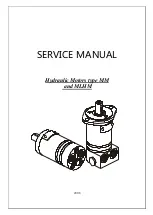
Page No: 57
Issue No: 1
Date: 031100
Issued By: PJA
The plunger (13) is located centrally in the cover (20) which is secured to the carburettor
housing by screws (21). The diaphragm (16) is connected to the plunger (13) by a
retaining ring (17) and four screws (18) and washers (19) each. The vacuum in the choke
tube acts on the top of the diaphragm and the plunger via a bore (U) in the plunger (13)
and attempts to lift the plunger against its own weight and spring (22). The considerably
lower vacuum between air filter and carburettor is applied to the underside of the
diaphragm via duct (V) as a reference pressure.
If the throttle valve (23) is opened when the plunger (13) is closed, then a vacuum will
build up in the small cross-section at the bottom of the plunger (13) which is sufficient to
provide a supply of fuel. The weight of the plunger (13) and the force of the spring (22)
are matched in such a way that this vacuum will be maintained with increasing speed until
the plunger has fully opened the carburettor cross-section. From this point onwards the
carburettor acts as a throttle valve carburettor with fixed choke tube. The vacuum
increases with increasing speed.
The space in the cover (20) above the plunger guide is vented through bore (D). Its
diameter is designed in such a way that it acts as a restrictor for air flowing in and out and
therefore acts as a vibration damper for the plunger.
On its way from the float chamber to the choke tube the fuel passes through the main jet
(1), the jet carrier (10) and the needle jet (3); as it leaves the needle jet it is pre-mixed
with air which is brought in from the air filter via an air duct (Z) and the atomiser (2) in
an annular flow around the needle jet. This air flow assists the atomising process to form
minute fuel droplets and thus favourably affects the fuel distribution in the intake
manifold and combustion in the engine.
The conical section of the jet needle (4) which is secured to the plunger (13) with the
retaining spring (14) and the serrated washer (15) engages into the needle jet (3).
Depending on the dimension of the flat cone at the end of the jet needle, the annular gap
between jet needle and needle jet is enlarged or decreased and thus the fuel supply is
throttled to a lesser or greater extent. The jet needle (4) can be located in the plunger (13)
in four different positions which, similarly to the jet needle cone, affect the amount of fuel
drawn in. For example "needle position 3" means that the jet needle has been suspended
from the retaining spring (14) with the third notch from the top. To achieve the height
adjustment the jet needle is turned through 90o and pushed up or down, the retaining
spring engaging the next notch in the jet needle. If the needle is suspended higher up, this
will result in a richer mixture and vice versa.
In short the main regulating system is set using main jets and needle jets of various
diameters and also jet needles, plungers and pistons of various types.
Between main jet (1) and nozzle stock (10) a washer (12) is provided which, together with
the float chamber, forms an annular gap. In particularly severe operating conditions this
ensures that the fuel is not spun away from the main jet.
A rubber ring (11) seals the nozzle stock (10 off from the carburettor housing to avoid any
fuel being drawn in via the thread and thus bypassing the main jet.
Summary of Contents for 3300
Page 4: ...Page No 4 Issue No 1 Date 031100 Issued By PJA List of Amendments Page Amendment Date Issue...
Page 8: ...Page No 8 Issue No 1 Date 031100 Issued By PJA 1 1 Denomination of Cylinders...
Page 11: ...Page No 11 Issue No 1 Date 031100 Issued By PJA 3 0 PERFORMANCE GRAPHS...
Page 48: ...Page No 48 Issue No 1 Date 031100 Issued By PJA...
Page 52: ...Page No 52 Issue No 1 Date 031100 Issued By PJA...
Page 67: ...Page No 67 Issue No 1 Date 031100 Issued By PJA Drawing 9430064...
Page 89: ...Page No 89 Issue No 2 Date 031100 Issued By PJA...
















































